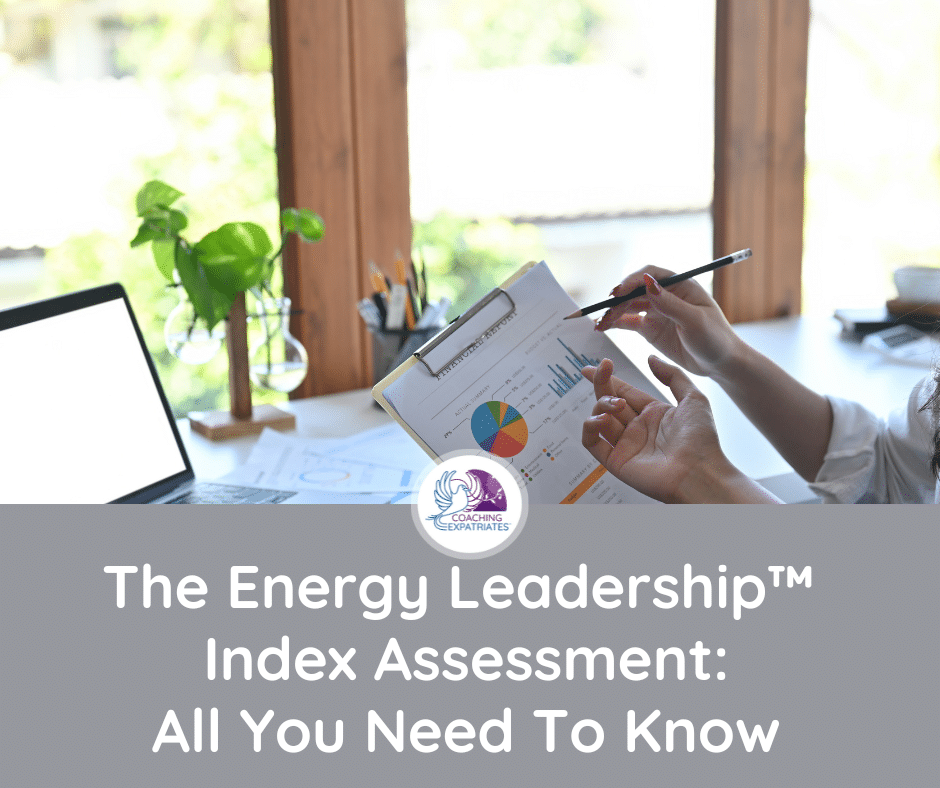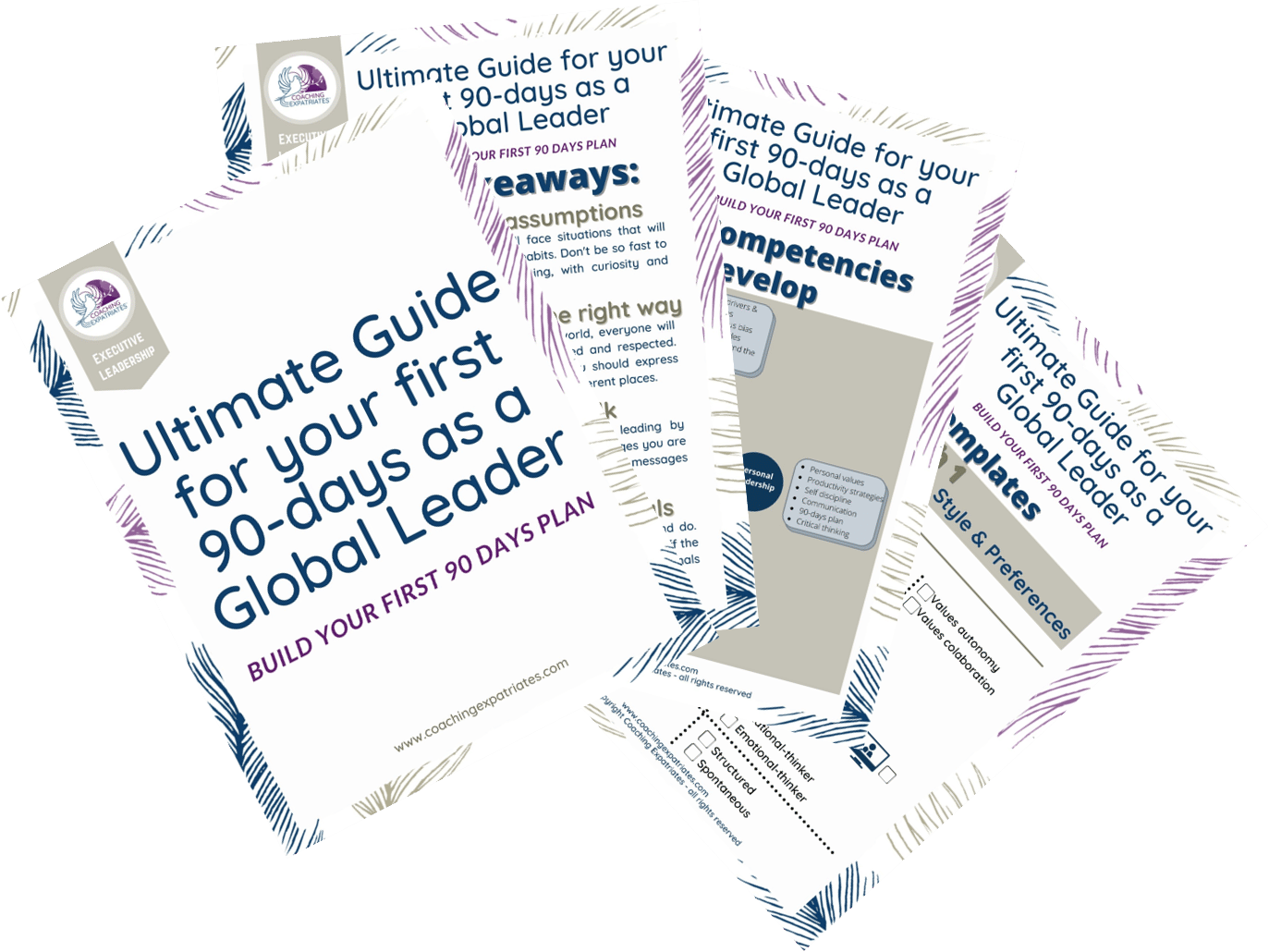Did you know that there are 7 different ways we can show up in any circumstance? I’m talking about our attitudes and how we are perceived by other people. Our attitudes, and the energy around us, can change the way people relate to us, trust us, and even how they do business with us. Because of this, our attitudes can impact success. During your leadership development to become a unique and inspiring global leader, this might be a topic you’ll want to investigate to improve all your skills in The Global Leadership Pillars™. Today, I will share a tool that can help scientifically measure “our attitude” and how we are showing up. This helps us create strategies to change our “energy” and elevate success. This tool is the Energy Leadership Index Assessment.
▶️ If this video is not laoding, you can watch it here: Coaching Expatriates Youtube Channel.
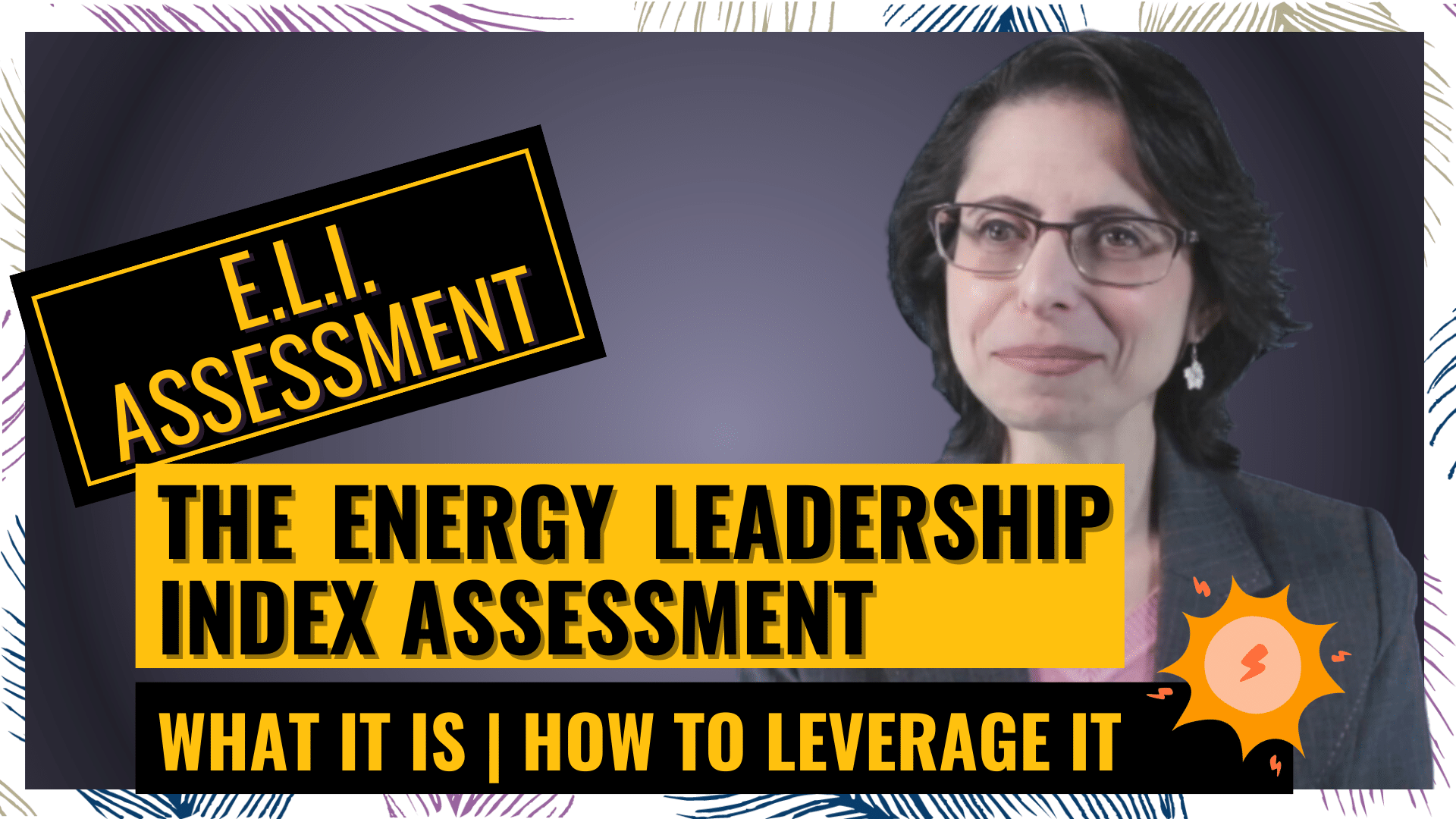
Table of Contents
What Is The Energy Leadership™ Index Assessment Or E.L.I.
The Energy Leadership™ Index Assessment is a professional attitudinal assessment that helps individuals understand how they are showing up in their lives; when they are in a good headspace and environment, and when they are in a stress mode, either because of what’s happening in their headspace, the environment, or both.
When I say “show up” it means how people around you actually perceive you. You know when people say “she is so bossy” or things like, “gosh, the boss is cranky today,” or when someone has a terrible attitude that makes you simply want to leave their presence?
The other way around, is when you are in the presence of people that are super upbeat and pleasant to be around. People that inspire you and even energize you.
So what’s going on here?
What’s going on is that our attitudes, or the way we show up, can be classified mainly into 7 categories that are called “Levels Of Energy Leadership™”.
Who Created The Energy Leadership™ Index Assessment
Listen, we have infinite types of attitudes that we can show up with. You can tell just by the labels that you used in the past to express those attitudes, like cranky, gloomy, energized, demanding, bossy, hopeful, etc.
Bruce D Schneider, the creator of this model, decided to try to simplify the worldview into a model so that we can quickly identify what’s going on and take specific actions to change our attitudes into how we really want to show up.
So when I say 7 categories or levels, it’s because the model tries to simplify reality so that we can make better sense of it.
If you read the incredible book, Power Versus Force, by the medical doctor and Ph.D. Dr. David R Hawkins, you know that our state of mind can be classified into 2 ways: a positive response and a negative response. When we are in a state of positive response or positive energy, he called it “anabolic state” or life-enhancing because it’s the type of energy that helps build and grow. When we are in a state of negative response or negative energy, we are in a “catabolic energy state,” meaning life-consuming, because it breaks down and destroys processes and life.
So what Bruce Schneider did, was expand this idea into an energy model, and I believe he called it Energy Leadership™, because it requires our personal leadership to drive our attitudes into better states and to greater leadership effectiveness. In his book, ‘Energy Leadership: Transforming Your Workplace and Your Life from the Core’, he explains the concept through an interesting and intriguing study case.
If you don’t yet know what’s your next read, I recommend getting this book for a light and informative read.
Overview Of The Energy Leadership™ Index Assessment Model
The model is brilliant because it helps us understand 3 aspects in each of the 7 levels that, together, will reflect on how we are showing up. These 3 aspects are: our core thoughts, at the moment we are in that attitude, our core feelings or emotions associated with those thoughts, and the actions or results from those thoughts and emotions. The model also helps us understand how our Ego is impacting how we show up.
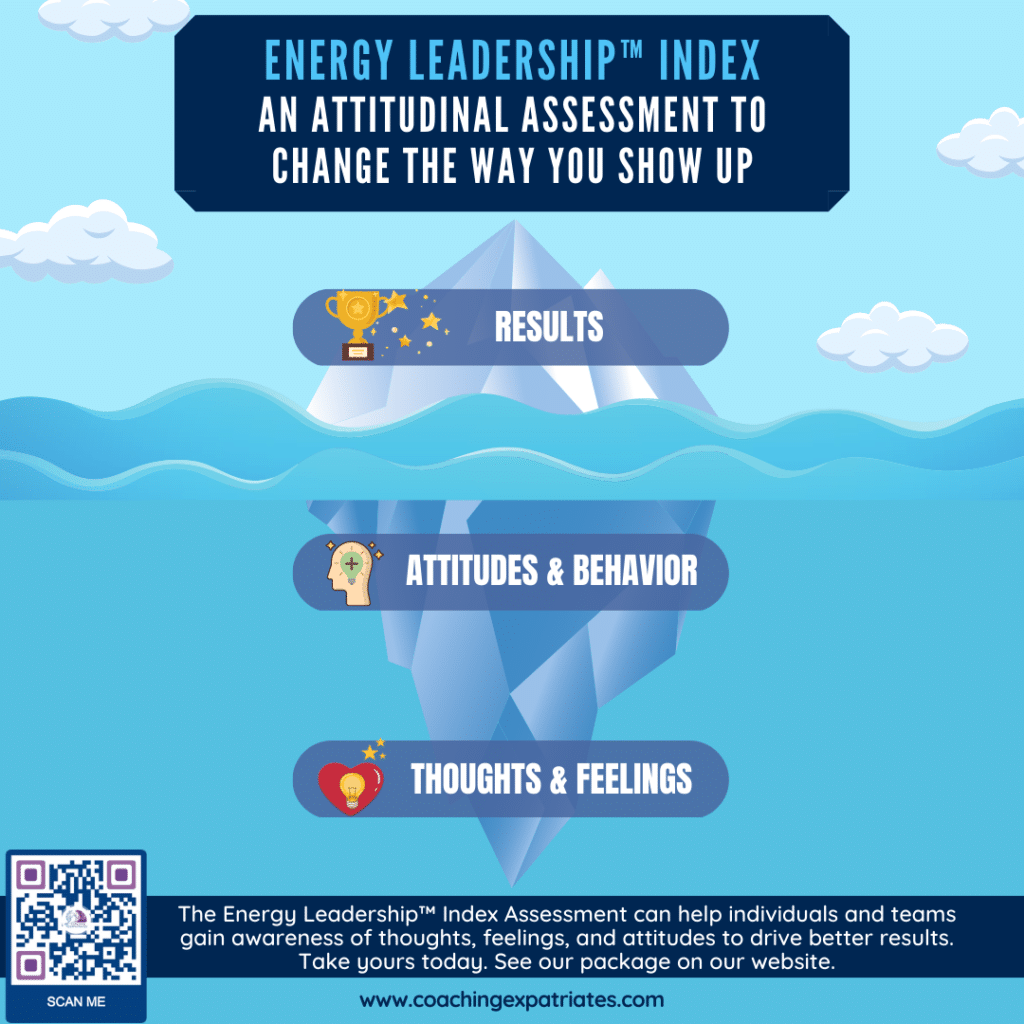
I think including the Ego in this equation is quite relevant, because sometimes what we say, do, or want are related to the demands of the Ego, e not from our hearts or brains. So the model helps us put things into this perspective to increase our self-awareness.
The Model: The 7 Levels Of Energy Leadership™:
So the generic model and its levels of leadership energy can be summarized like this:
Energy Level One, The Victim. You are in a catabolic state which uses a lot of anabolic energy (or negative response), so it’s not a good state to be in, and you will not show up in a cool way for others. Your core thought is of a victim, so all you can see is a lack of choice, as if things are happening to you, against your choice and will. Your core feeling is apathy. When you have victim energy, nothing seems fun, and you feel a lack of interest and enthusiasm; everything seems to be wrong, and all you want is to just crawl into your bed. So it’s a feeling of deep apathy. The core result of this is Lethargy. You procrastinate, you avoid, and you are so out of sorts, that you just want to be left alone.
Energy Level Two, The Antagonist. You are still in a catabolic space here. The core thought is conflict, The core emotion is anger, and the action or results from this is defiance. So you are in an attitude of confrontation and defiance. Just a side note: this is a very easy state to get into. It happens every time we get angry about something or when things don’t go our way, and we become frustrated.
Energy Level Three, The Rationalizer. You start to leave the catabolic space and start to integrate some anabolic state. However, it’s still more catabolic than anabolic. The core thought here is responsibility, so you pull responsibility for yourself, let people off the hook, and settle for less just to avoid conflict. There is a lot of overthinking and rationalization in this space. The core feeling is forgiveness, and the action or result is cooperation. Cooperation sounds great, but the reason why you are cooperating is still catabolic because most people operating on this level are self-sacrificing, and they are not really voicing their needs. They are being passive, in a certain way, in the name of responsibility and agreeability.
Energy Level Four, The Helper. At this level, you have already completely left the catabolic space and are operating totally in an anabolic or constructive space. And from now on, all other levels will be in this anabolic space. The core thought is concern, especially for others, and the core feeling is compassion. The result is being of service to other people. A lot of psychologists, counselors, coaches, HRs usually live in this kind of space and attitude.
Energy Level Five, The Collaborator. The core thought is of reconciliation, or how can you figure out a win-win opportunity. The core feeling associated with this level is peace. And if you operate a lot from this level, you really feel at peace, because you can see the opportunities, and you know that you can transform them into something valuable to you. So you are at peace, especially with yourself. The result is acceptance. You accept others, you accept situations, and you are willing to transform them into good opportunities. Top producers and sales reps, and very charismatic people in general, usually operate in this state.
Energy Level Six, The Creator. This is the first state in which you completely move out from the Ego. Your thoughts and feelings are not influenced by ego anymore from this state on. The core thought is synthesis, which is the combination of ideas to give form to something, like a special project, a dream, or a vision. The core emotion is joy. And it makes sense to feel joy if we are in this state, because it’s a space where we see a lot of good things happening, or we are excited to make them happen. The result is wisdom. We learn from what we experience, from the process, and from the people around us. So it’s a state of wisdom not only for you but for those who are joining you in your projects. This is a very difficult state to achieve because it requires a lot of personal leadership, especially in the element of the mental game and quieting the ego. If you want to learn more about Personal Leadership, I recommend you watch this video next.
Energy Level Seven, The Passionate. The core thought here is non-judgment and pure observation of facts and experiencing existence. Remember, ego is completely out of the way here, so you don’t judge things and people. The core feeling is an absolute passion. A state of complete passion and unconditional love. You see the connectedness of all beings and creation. So the result is co-creation. When you are in this state, things happen synchronistically. You need the right person, and boom, it appears. You need resources; boom, it’s there. Because you are in this flow of connection with all things, it’s almost like you can coordinate those things to happen. It’s very rare to see people operating in this state as their main attitude, but by raising our awareness about our attitudes, we can spend more moments in these greater states, like levels 6 and 7.
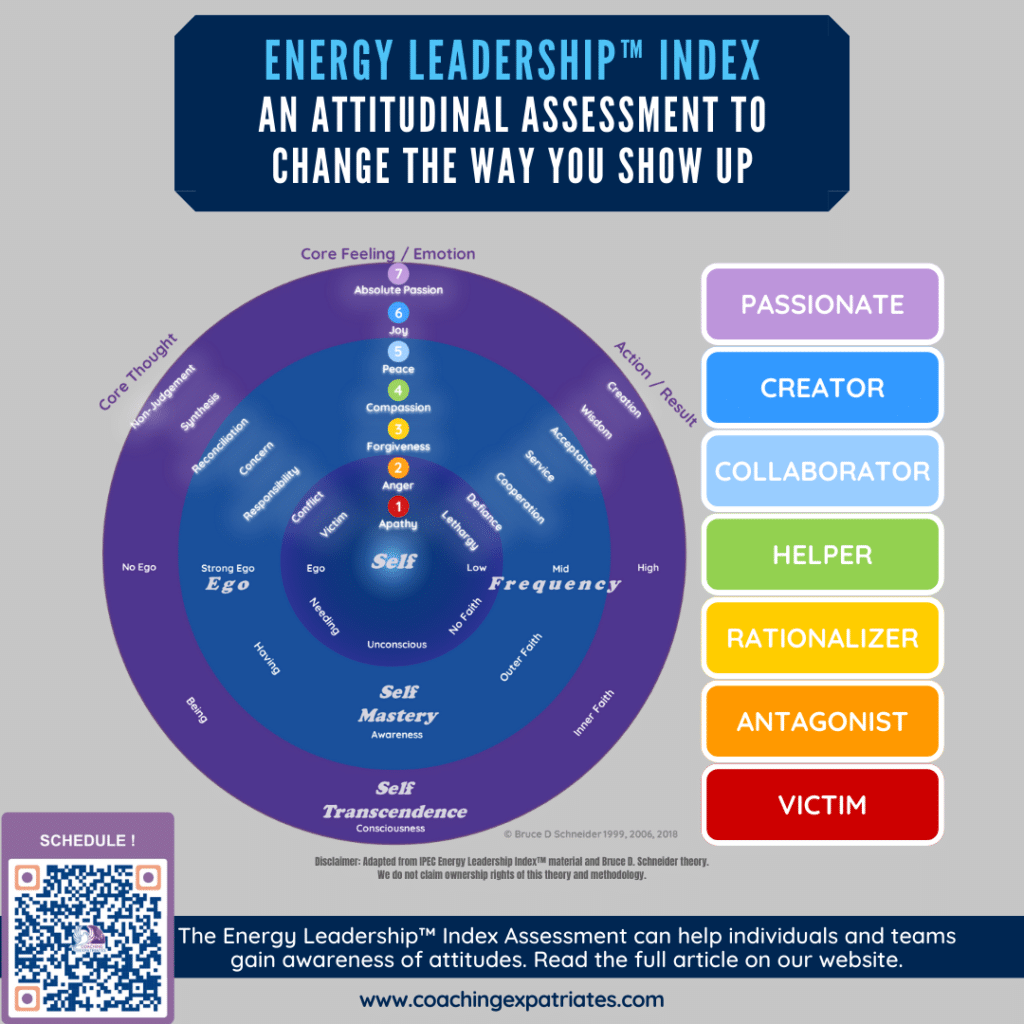
When you take the assessment, it basically tells how much energy you spend on each of these levels.
It gives you which level you usually operate from, as your main attitude, as well as 2 other attitudes that you usually gravitate towards the most, besides your main one. It provides you with a visual chart, showing how much energy you are using in each of these levels. 2 charts are presented: one, when you are in a regular mode, meaning when you are in a normal state of mind and in a good environment. And, a second chart, when you are in a stress mode: meaning when you are under mental or physical stress, or in a stressful environment.
Does The Energy Leadership™ Index Assessment Have a 360° Version?
Besides the regular Energy Leadership™ Index assessment, there is a cool version of it, meant to help corporate employees close perception gaps, by using a 360-degree assessment model.
In this model, various people across the organization will be selected to fill out an assessment about you. This will produce results showing how people perceive you, or how you are showing up for them. Then, this will be compared to what your own assessment results say. This way, you will be able to see how you show up, and how others perceive you. If there are any gaps in perception, you and your coach will be able to talk about it and come up with a plan.
Closing Perception Gaps
Very often, there will be a disconnect between how you think your attitudes are and how people see you. When this happens, you’ll want to close perception gaps to improve the way you are showing up and communicating. If you work with a global team, there are many facets to multicultural communication, but some of them can be totally attitude related.
For example, you might show up as an angry and disagreeable person, full of Level 2 to other people, while your own chart might show a lot of energy 3. To you, you are being passive and trying to accommodate people as much as possible while communicating to the best of your abilities, but to others, they are viewing you as confrontational and obstructive. In this case, the issue might not lie in communication, but in how you are presenting it and showing up.
Gaining awareness about these types of perception gaps can help us create strategies to show up in new innovative, and more productive ways. For example, you might end up finding out with your executive coach that you want to show up neither with Level 2 or 3 for people. Instead, you decide to show up more of 4 and 5 and come up with an experiment with your coach, to change your attitudes and habits. And by tweaking your daily attitudes, you might start seeing impressive results in communication.
On the other hand, a very often situation is when there are no gaps in perception. How you are showing up and how people perceive you are quite the same, but still, you don’t like how you are showing up altogether. For example, you can be showing a lot of level 2, as in the previous example, but in this new example, that’s how people also perceive you. After your conversation with your executive coach, you find this current main Energy Level relatively unproductive, as it might be creating roadblocks for your relationships, trust-building, and even health issues. So you both come up with a plan to change this.
As you can see, either way, you’ll gain massive power by developing this sort of awareness because you’ll be able to come up with innovative strategies to test out and form new habits of thinking, feeling, and doing until they become second nature and part of your new set of main attitudes.
Team Energy
This version of the assessment is also super cool because it provides a Team Energy Score. In other words, it provides a chart for the entire team who participated in the assessment, as well as their E-Factor score. So, it defines which is the main team level, the secondary level, and the central team score, which is equivalent to the individual E-Factor.
For example, a team that is using a lot of Level 2 might feel like a toxic and unproductive team since there is a lot of aggressiveness and combativeness. A team with a lot of Level 3 might feel like a team where rule sets are not well defined, and people are trying to cope and be agreeable, but there is still a lot of resentment or confusion underneath.
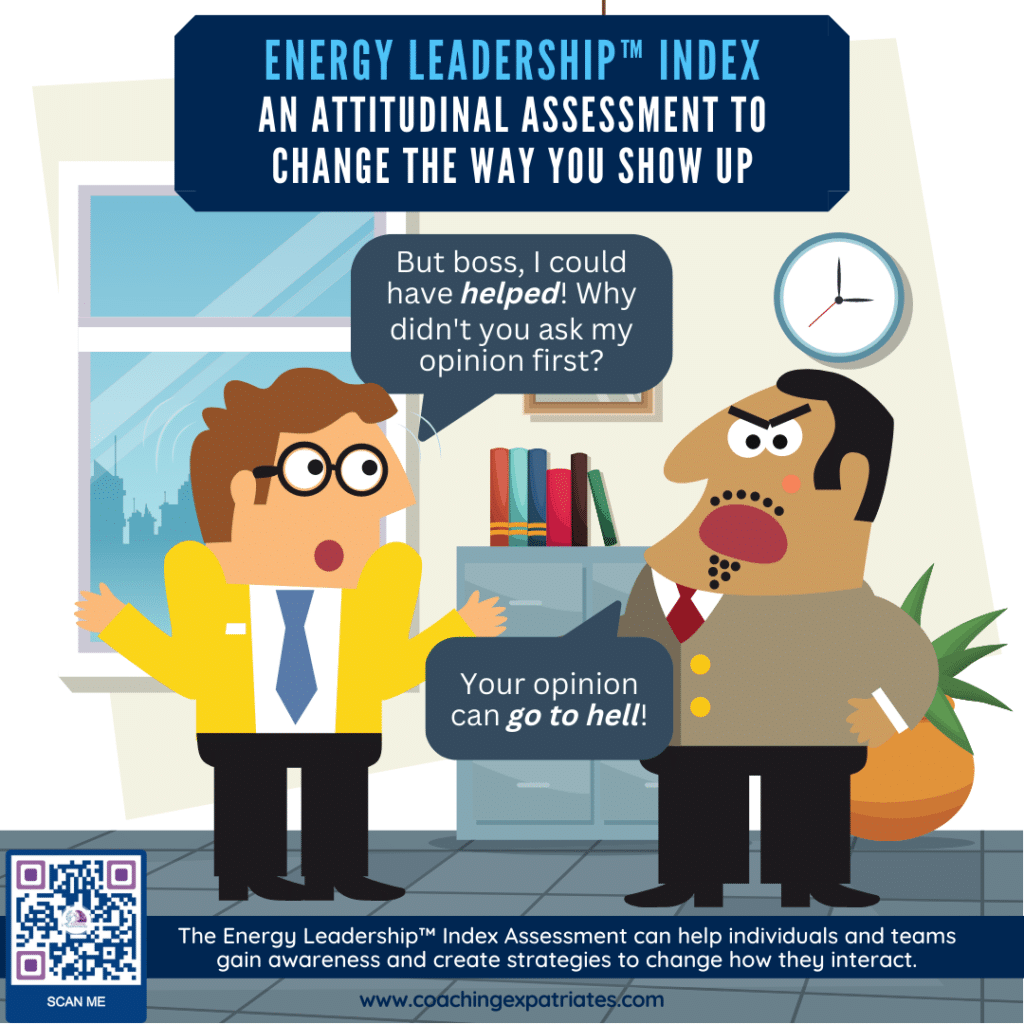
Each case is a different case, but knowing which levels the entire team shares the most, helps the leadership or manager navigate that team better and create strategies to build new forms of team energy to improve team performance. The strategies then can be tested after six months or a year, and see how well the team improved in terms of energy, and, of course, attitude. This helps teams improve performance and retain top talents within the organization.
A lot of organizations that have this retention mindset in their cultural leadership create winning teams and winning cultures, because they learn how to perform together and how to celebrate their victories and learn from their mistakes. It’s all attached to attitudes.
How It Compares With Other HR Assessments
There are many types of assessments in the market used for the purpose of developing and improving leadership ability. Leadership assessments like The Myers Briggs, Type Indicator, DiSC, Hogan, and StrenghFinder, now called CliftonStrenghts are assessments that tackle more the personality types and traits aspect than attitudes themselves.
For example, you can be mainly Dominant in the DiSC assessment report, but you can be a “shitty” dominant or an “inspiring” dominant. And it all depends on your attitude toward self and others.
Another important thing to mention is that these personality and traits assessments, if taken from official sources, can be expensive, and they usually only offer a report, without an executive coach providing you with a debrief session, where you can discuss actions. Quite frankly, gaining awareness alone and doing nothing about it is almost like buying a lot of food and letting it rot in your pantry. It’s a waste of money.
The Energy Leadership™ Index Assessment, however, is not only quite affordable, when given by official and certified coaches, but also provides a coaching session for debrief of your report. So I think it’s much more personalized, and the conversation is much more customized to your needs since you get a personalized session to discuss strategy and action points.
By the way, if you are interested in taking the E.L.I. to use this attitudinal assessment tool to create development strategies for your executive presence, you can explore this link with my package.
Why Forbes Magazine Recommends The E.L.I.
The reason why it’s so cool is because it’s an attitudinal assessment, not a personality assessment or personality tests. Personalities are usually very difficult to change. However, we can easily change our attitudes, so long as we know exactly how we are showing up and how people are perceiving us.
Because this assessment helps us gauge our attitudes, it’s a valuable tool that has numerous applications. It can be applied to help you improve your relationships, it can be used to help improve your mental health & self-satisfaction, and it can be used to improve your executive presence, if you are a global executive, for example.
Extra Assessment Tools: The Scope App
The assessment also allows the use of a free App, called SCOPE, which you can use anytime during the day to have quick self-assessment. Throughout the day, or before a difficult conversation or meeting, for example, you can use the App to check which levels you are in.
This means you can use the App to check in with yourself and see which of the 7 levels you are in at that very moment you are using the App. And it even gives tips to quickly shift your attitude and mental state, if so you desire.
For example, let’s say you are presenting a business case where you must convince a Leadership audience to approve a new initiative. You want to show up with a lot of Energy Level 5 and 6, but the App shows that you are filled with Level 2. After you check in with yourself before the meeting, you decide to have a quick conversation with your executive coach, or a close mentor, to quickly move your state to a more positive one before the meeting. People use the App in different and novel ways, but it can be crucial for helping you in difficult moments.
Pretty awesome, right?!
Research Behind The Energy Leadership™ Index Assessment (ELI)
An ELI reliability test was conducted to identify how valid this tool is. it was performed with data from more than 29 thousand respondents, and the validity test’s outcome shows that the assessment accurately reflects the participant’s results, and the tool is extremely reliable.
Futher research shows that the higher a person’s E-Factor is, the greater the overall life and work satisfaction and success is. The E-Factor is a score provided with the levels chart showing your personal level score, which is a combination of how much energy and weight you have in each of the levels. Participants were measured based on the E.L.I assessment. Read more in this press release on our website and its associated research.
There is also a lot of evidence showing that the E.L.I. can help teams move from a catabolic state to a more anabolic one and improve overall team performance. On our website, we present an article that talks about Corporate toxic environments, some of their symptoms, and how the E.L.I. 360° and Core Energy Coaching™ programs can improve overall employee engagement, motivation, and performance. It also shows how anabolic leaders make the shift.
The Energy Leadership Index™ Assessment is not just another fancy assessment. It’s a scientific tool to help gauge attitudes and create the right awareness to improve how we show up through strategies, mindset shifts, and a lot of habit change work. It can be done, and it’s extremely beneficial, not only to you but to all those around you.
Examples Of The Energy Leadership™ Index Assessment Use Cases
Corporate Development Opportunities:
A corporate executive seeking to become an effective leader, with a higher executive presence, and wanting to improve leadership skills will probably seek this kind of attitudinal online assessment. They might also want to use this tool to understand their automatic reactions in stressful situations during their jobs. Because this assessment provides the awareness to catapult potential growth, they might also look into this type of assessment when creating a development plan for themselves and their direct reports. Because the 360° version of the assessment also provides combined energy scores for the team, they might also seek this type of assessment to close the team’s blind spots and improve overall team performance and leadership competencies.
General Professional Development:
Entrepreneurs, lawyers, medical doctors, social workers, and any other professional will seek this type of assessment to help them improve the way they show up for their clients, co-workers, or subordinates and improve their business and profits. It’s undeniable that people do business with people they know, like, and trust. Liking is an important factor nowadays. With so much competition out there, there are always people who provide similar things and services that we do. But our uniqueness, how we show up, and how we express our values through our attitudes can be a make or break. This assessment can help professionals improve their likeability without giving up their authenticity.
Personal Awareness:
If you think the Energy Leadership Assessment and its 360 version works only for professional environments, you are wrong. It’s also been used in the personal awareness industry and parenting industry to help families improve their relationships and way of living. The tools can be extremely powerful in understanding what is going on with personal groups like families, churches, associations, and so many more applications that go out of the work environment.
Team Effectiveness:
As shown in a previous example, the 360 version of the ELI can be a powerful tool for understanding team dynamics. But more than that, it helps understand what’s underneath the team’s dynamic, so that the leader and the team can work with their coach to start changing it into something more productive. Many teams in the storming phase present a lot of Level 2 dynamics, while teams in forming phase will tend to show a lot of Level 3. Teams in the performing phase tend to show higher energies that are productive and constructive to the team members and to the company. Using the assessment can give team members and leaders the right tools and awareness to work on the right topics.
Relationship Improvements:
One of the most sought-after use cases for the ELI assessment is when people want to improve their relationships. Sometimes, issues in relationships can be related to team dynamics: how you interact with those people in the relationships. Sometimes, though, it’s solely related to how we are showing up.
People going through life changes and transitions, traumatizing situations, health deterioration, and other life-changing events can change the way they show up. They can start to display poor attitudes because their minds are overwhelmed with fear, frustration, resentment, and anger. This tool is not a substitute for proper professional health care, advice, and medications, but it can be helpful once the situation is under control and what’s left is changing the way we feel and act, which might be impacting relationships.
Where Can I Take The Assessment?
Each certified coach that can give you the official Energy Leadership™ Index Assessment will offer different things and their own quirks and perks, and even a different assessment pricing structure depending on what they are including. But all of them have to give you, at least, the official Energy Leadership report and a debrief session. Otherwise, it’s not exactly official.
I am a certified ELI coach that can offer you to take this ELI assessment. My package includes, of course, the official Energy Leadership™ report and a full assessment 80 minutes debrief session about your report, and also the use of the App.
Although the App is free for the user, you won’t unlock all its potential without a coach who is paying a license for you with the full features. When you use the App with your coach, your coach has some visibility to help you with habit improvement and other interesting possibilities using the App on a more consistent basis. The E.L.I assessment is a picture, after all. It tells your overall use of Energy Leadership, but things change during the day and depending on the circumstance, and the App is perfect for capturing these little situations.
And the main way I help people use this assessment, is by enhancing their executive presence at work. So if you want to be perceived in a better way at work, showing up with greater executive presence, even if you are not yet an executive, I highly recommend this assessment for you.
The ELI Assessment Process
The process is quite simple. Once you purchase a package, your coach will secure you a link to answer some questions. This questionnaire will take you no longer than 30 minutes, and it’s advised that you answer it as fast as possible, without dwelling too much on each question. After all, we want the truest and most unconscious answer possible.
Once you filled the questionnaire out, your coach will receive and process the data, prepare the reports, and analyze your data to prepare for the debrief. Then they will contact you to set a date for this debrief. It’s recommended that the debrief date happens not too long after the questionnaire is filled out.
During the debrief, you’ll be given your report and results, and the coach will explain what they might mean for you. Then, both of you will brainstorm possible alternatives for action plans, and come up with a structured action plan to start working on how you really want to show up.
Many individuals take the E.L.I. again after some time, to see how much improvement or change they’ve seen since they started working on it. It’s not advisable to take the assessment again in less than a year. Also, it’s important to highlight that the debrief alone will not help you through the improvement process; it will help you with guidelines.
It’s like when you want to study for an exam: you may acquire a book, but if you don’t read it and study it, the chances of passing the exam are dim. The ELI debrief session is like acquiring the book. But you still have to read it and study it to improve.
The best recommendation is to hire a Core Energy™ Coach, that is formally trained to help through this attitudinal shift process and then take the assessment again between 6 to 12 months after you start working with this coach.
Final Remarks
In a nutshell, the Energy Leadership Index assessment is an effective tool for personal and professional development, helping individuals gain insight into their attitudes and relationships. By identifying their energy levels, individuals can better understand how they interact with others and approach challenges, ultimately leading to greater success in all areas of life. The assessment provides a framework for individuals to improve their leadership skills and develop a positive and empowering mindset, resulting in increased confidence, productivity, and overall well-being. With the Energy Leadership Index assessment, individuals can take control of their lives and become the best version of themselves.
One important note is that energy is not good or bad, and the levels are not made of good or bad levels. Anabolic and catabolic are referred to the most common ways those energies are used in, but they don’t mean good or bad. In other words, it’s up to us to use each Energy Level according to how we want to show up and be perceived. Mastering the use of each level requires, first, our awareness of our usual attitudes, though. You can then work with a Core Energy™ coach to learn how to master each level to your advantage based on different situations.
If you are looking for a leadership development partner and consultant to help you implement some of these ideas, you can hire me as your executive and development coach. Have a Free Strategy Call with me. We will go over your teams’ data and dynamics, and devise together the top priority initiatives and their budgets. If that’s a personal initiative, we can also deep dive into your main areas of desired improvement.
If you are interested in developing specific global leadership skills, personally or team-wise, check out our online Global Executive Leadership Program. We go over all The Global Leadership Pillars™ during 9 online modules, specially meant for global leadership development. It’s a unique leadership training methodology that will change the way you think, relate, and strategize as a global leader.
If you enjoyed this post, consider subscribing to our newsletter using the form below. We focus on providing good content to global leaders and executives who want to make impactful business decisions and be more inclusive and influential. We know your inbox is sacred, so we email just once per week, and we never sell, rent or do anything funky with your information. Trust is the basis of Global Leadership, and we fully honor it.

